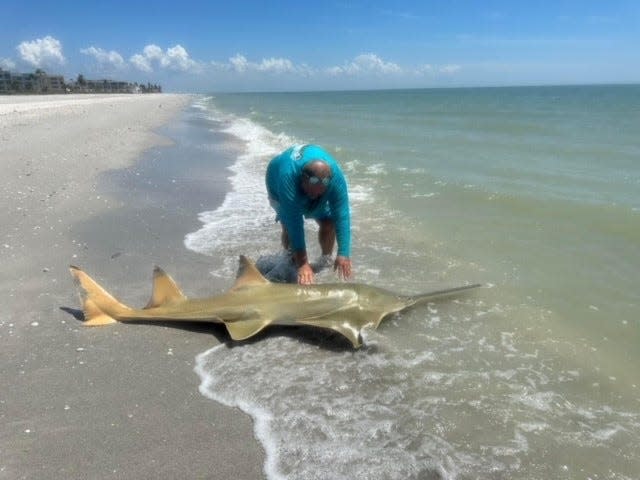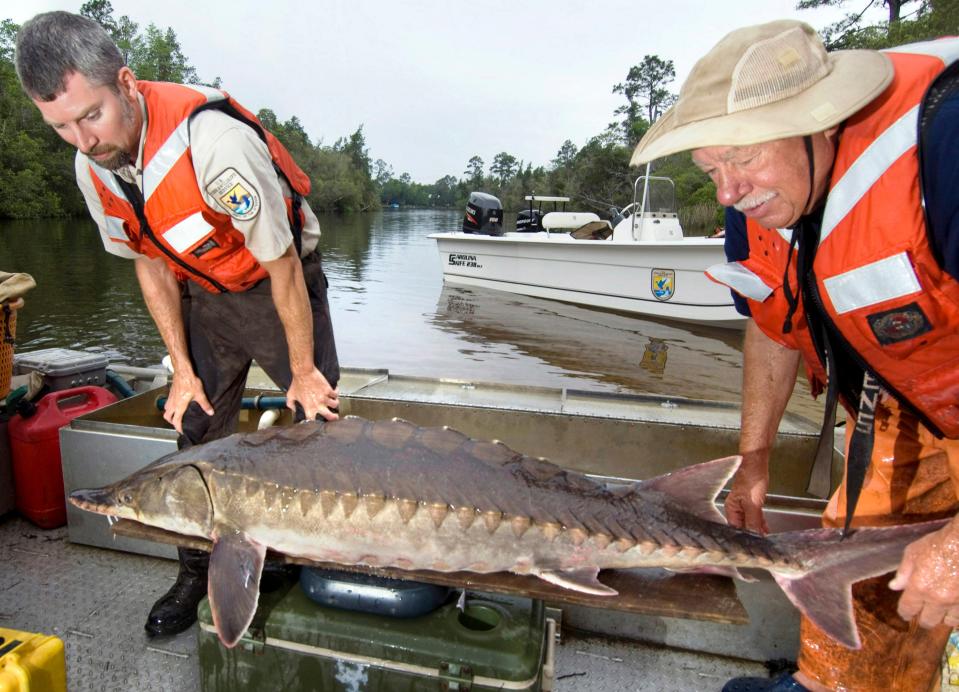Prehistoric fish in Florida: Details about smalltooth sawfish, alligator gar, Gulf sturgeon
Living in Florida is never boring.
It may be hot, but we get excited when a "cold front" is predicted that will drop temperatures into the 80s or, gasp, the 70s. And who knows, we might — emphasize might — get temperatures cool enough to look up ... for falling iguanas.
We shake our heads in amazement over alligators climbing fences and just wait patiently when they pass through golf courses, giving new meaning to the expression of watching those water hazards.
We have the National Hurricane Center bookmarked on our phones and know at any moment the case of water and jar of peanut butter we bought in June might be called into play. Oh wait, we used the last of it for those peanut butter cookies last week. Back to the store to restock our emergency kits before the shelves are bare again.
And while it's easy to focus on the entertainment available in Florida — not to mention wildlife that skip the lines and make themselves at home in the Magic Kingdom — there is a prehistoric past that's around today, and we're not talking about finding rare shells or searching for shark teeth.
Let's go back further in time and then jump into the present with several prehistoric fish you can find in or around Florida, including the smalltooth sawfish, the Gulf sturgeon and the Florida gar.
➤ Interactive map: Florida fish dating back to Jurassic period
Official dinosaur-fossil by state: Did you know most states have an official dinosaur or fossil? It's true! Here's yours.
Smalltooth sawfish in Florida can reach up to 18 feet long

The smalltooth sawfish is a fish that belongs in the same class as sharks and rays. It can reach up to 18 feet long, including the saw, which is known as the rostrum, according to the Florida Fish and Wildlife Conservation Commission.
There's little information about what the smalltooth sawfish eats, although their diet is thought to include crabs, shrimp and small fish.
Juvenile smalltooth sawfish live in coastal areas, such as estuaries, river mouths and bays throughout the year, especially along red mangrove shorelines. Juveniles use creeks and canals that connect to the main branches of rivers as habitat, according to the FWC.
Adult smalltooth sawfish are typically found in open water, but have been found near coral reefs and inshore during the spring when females give birth and mating is thought to occur.
Although the historical range used to extend from the U.S. down to Brazil, smalltooth sawfish are found primarily from Charlotte Harbor to the Florida Keys.
The smalltooth sawfish is protected as an endangered species by the Federal Endangered Species Act and as a federally designated endangered species by Florida’s Endangered and Threatened Species Rule.
They should be released unharmed if accidentally caught while fishing for other species. Sawfish rostrums should never be removed.
To report a sawfish sighting:
E-mail: sawfish@myfwc.com
Telephone: Call 844-472-9347 (844-4SAWFISH)
Include the date and time of the encounter, the location, the estimated length of each sawfish, the water depth, and any other relevant details.
Where is Gulf sturgeon, known for whiskers and caviar, found in Florida?

The Gulf sturgeon is also known as the Gulf of Mexico sturgeon and is one of seven species of sturgeon found in North America, according to the FWC. Sturgeons date back to the time of dinosaurs. Sturgeons are popular as a source of caviar.
The Gulf sturgeon can grow longer than six feet and have fleshy "whiskers" on its long snout, and no internal skeleton. They may live for more than 40 years.
Watch out: They can pose a danger to boaters since they have a tendency to jump.
Boaters have been injured by direct strikes with sturgeon, and there is no warning. In 2015, there were five accidents reported that involved sturgeon strikes, the FWC reported. Three accidents occurred on the Suwannee River and two happened on the Santa Fe River. The accidents involved one fatality and eight injuries.
Gulf sturgeon spend a part of their lives in saltwater, but travel upstream in freshwater rivers to spawn. For Gulf sturgeon, which are found from Florida to Louisiana, they move from salt to fresh water between February and April and return to salt water habitats between September and November.
They spend the winter in the Gulf of Mexico in sandy-bottom habitats six to 100 feet deep, where their diet consists of marine worms, grass shrimp, crabs and a variety of other bottom-dwelling organisms. They eat very little while in freshwater rivers.
Gulf sturgeon can be found from the Mississippi River in Louisiana, east to the Suwannee River in Florida, according to the FWC. The Suwannee River is home to the largest population of Gulf sturgeon in Florida.
Prehistoric find: Jogger finds fish dating back to 200 million years ago
To report sturgeon strikes, call the Wildlife Alert Hotline at 888-404-3922 (888-404-FWCC).
Gulf sturgeon are protected as a threatened species by the Federal Endangered Species Act and as a federally designated threatened species by Florida’s Endangered and Threatened Species Rule. Gulf sturgeon habitat is protected by the Federal Clean Water Act.
Gulf sturgeon and oyster reefs: Could artificial oyster reefs help threatened Gulf sturgeon?
Making a comeback: Sturgeon, America's forgotten dinosaurs, slowly coming back
What do Florida gar, Alligator gar look like?
The Florida gar is a prehistoric fish with bony scales that form a hard armor.
Alligator gar are long, slender fish with bony, diamond-shaped scales. They are distinguished from other gar by a heavier body and a relatively shorter, broader snout filled with two rows of canine-like teeth. Alligator gar generally have a dark, olive green body that fades into a white belly, and their fins are often a reddish-pink.
The Florida gar can be found in the Ochlockonee River and waters east and south in peninsular Florida, according to the FWC.
In Florida, alligator gar are only known to inhabit coastal rivers in the Panhandle from Gulf County to Escambia County.
Florida gar use an airbladder to breathe air in low-oxygen water. Spawning occurs in late winter and early spring when both sexes congregate in shallow weedy waters.
Alligator gar spawn from April to June, when water temperatures reach 77 degrees.
The largest recorded alligator gar in Florida is a 132-pound fish captured in the Yellow River in 2011 by researchers with the U.S. Fish and Wildlife Service and the FWC. No state angling record exists because only those with a scientific collector’s permit can possess and harvest this species in Florida.
In 2011, a commercial fisherman accidentally caught the largest alligator gar on record in Mississippi’s Lake Chotard. The gar was 8.5 feet long, weighed 327 pounds and was believed to be 94 years old.
Armored catfish in Florida?
Florida and the St. Johns River have become home to several species of non-native or invasive armored suckermouth catfish that were originally purchased by aquarium owners as algae-eaters.
They all have rows of bony plates covering their entire body except for their bellies, along with a disc-like mouth under the head that is used like a suction cup to attach and feed on algae-encrusted objects.
Catfish 101: From armored, bullhead, channel, sucker-mouthed to white, the St. Johns has them
More prehistoric fish alive today
What is Arapaima fish?
The arapaima is among the largest known freshwater fish species with sizes up to 14 feet and 440 pounds.
They have a streamlined, oval shape with a large, flattened head. The body is covered by very large scales that are generally gray to gray green in color but many scales towards the tail have red markings.
What is Lancetfish?
Lancetfish live mainly in tropical and subtropical waters, but they migrate as far north as subarctic areas like Alaska’s Bering Sea to feed, according to NOAA Fisheries.
Lancetfish are scaleless fish, with smooth skin and pores along the lateral line. They have gaping fanged jaws, enormous eyes, a sail-like fin, and long, slithery body.
They can grow to more than 7 feet long and are are one of the largest deep-sea fish. They can swim to depths more than a mile below the sea surface.
What is Arowana fish?
Today, arowana are found in the Amazon and in parts of Africa, Asia and Australia, according to listverse.com.
Arowanas are predators that feed on any small animal they can catch, including birds and bats, which they catch by leaping up to six feet out of the water.
What is a Frilled shark?
Seldom seen alive, the frilled shark can grow just over 6 feet long. They live in deep waters, where they feed mostly on squid. Only dead or dying specimens are usually seen and recorded by fishermen or scientists.
Are 'dinosaur eels' fish?
The Polypterus Senegalus is an African fish are often called “dinosaur eels,” because of their reptilian appearance and serrated dorsal fin.
Although often sold as exotic pets, dinosaur eels are prone to escaping their fish tanks. They can survive out of the water for long periods of time as long as their skin remains wet, according to listverse.com.
What are Coelacanths?
Coelacanths were thought to be extinct until a live one was caught in South Africa in 1938. Others have been seen and photographed since then.
They're usually found in deep, dark waters.
This article originally appeared on Treasure Coast Newspapers: Sawfish, alligator gar, Gulf sturgeon, armored catfish: Things to know

